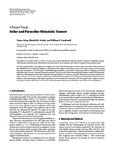Filters: Collection: "ir_uspace"
| Creator | Title | Description | Subject | Date | ||
|---|---|---|---|---|---|---|
| 1 |
 |
Schmidt, Meic H. | Surgical technique and results of endoscopic anterior spinal canal decompression | Object. Decompression of the spinal canal in the management of thoracolumbar trauma is controversial, but many authors have advocated decompression in patients with severe canal compromise and neurological deficits. Anterior decompression, corpectomy, and fusion have been shown to be more reliable f... | Anterior approach; Anterior decompression; Spinal trauma; Endoscopy | 2005 |
| 2 |
 |
Love, April M. | Hidden water: Salt Lake County, UT drainages, a part of the Western Waters Digital Library | Salt Lake Valley watershed, hidden water | 2012 | |
| 3 |
 |
Couldwell, William T. | Transmaxillary approach to the anterior cavernous sinus: a microanatomic study | OBJECTIVE: Several approaches to expose the anterior cavernous sinus have been used, such as frontotemporal, orbitofrontal, anterior subtemporal, and various transfacial approaches. In an effort to gain exposure to the anterior cavernous sinus without necessitating a craniotomy or wide transfacial ... | Anterior cavernous sinus; Clivus; Cranial base; Maxillary sinus | 1997 |
| 4 |
 |
Shapiro, Michael D. | Cynodont from the Upper Triassic of East Greenland: tooth replacement and double-rootedness | A new genus and species of cynodont from the Upper Triassic Fleming Fjord Formation of East Greenland possesses double-rooted postcanine teeth and a nonalternate pattern of tooth replacement. The specimen represents an addition to the known diversity of Early Mesozoic taxa with multi-rooted dentitio... | Mitredon cromptoni; Cynodont; Upper Triassic; East Greenland; Fleming Fjord Formation; Tooth replacement; Double-rootedness; Multi-rooted dentition | 2001 |
| 5 |
 |
Digre, Kathleen B.; Schmidt, Richard H.; Osborne, Anne G.; Patel, Bhupendra C.; Pratt, David; Rietz, Lisa A. | Compressive optic neuropathy caused by renal osteodystrophy. Case report. | Compressive optic neuropathy with acute or chronic vision loss has been associated with various skull base tumors, aneurysms, Graves disease, trauma, and, less commonly, fibrous dysplasia and osteopetrosis. The Author's present a case of acute visual deterioration in a 25-year-old woman who had mass... | Optic Neuropathy; Optic Nerve Decompression; Renal Osteodystrophy | 2001-10 |
| 6 |
 |
Schmidt, Meic H. | Thoracoscopic vertebral body replacement with an expandable cage after ventral spinal canal decompression | OBJECTIVE: Minimally invasive thoracic anterior surgery using a thoracoscopic approach has evolved to include spinal biopsy, debridement, discectomy, decompressive corpectomy, interbody fusions, and internal fixations. Minimal access techniques can potentially decrease surgical access morbidity and... | 2007-01-01 | |
| 7 |
 |
Mansour, Suzanne L. | Fgf10 is required for specification of non-sensory regions of the cochlear epithelium | The vertebrate inner ear is a morphologically complex sensory organ comprised of two compartments, the dorsal vestibular apparatus and the ventral cochlear duct, required for motion and sound detection, respectively. Fgf10, in addition to Fgf3, is necessary for the earliest stage of otic placode ind... | 2014-01-01 | |
| 8 |
 |
Couldwell, William T. | Combined transmastoid retro- and infralabyrinthine transjugular transcondylar transtubercular high cervical approach for resection of glomus jugulare tumors | COMPLEX TUMORS OF the glomus jugulare present a surgical challenge because of their difficult location, extreme vascularity, and involvement with multiple cranial nerves. Modern microneurosurgical and cranial base techniques have enabled safe total removal of these complicated tumors. We describe a ... | Cranial base approach; Surgical approach; Glomus jugulare tumor; Jugular foramen exposure; Microsurgical anatomy | 2006 |
| 9 |
 |
Schmidt, Meic H. | Diffuse large B-cell lymphoma presenting as a sacral tumor | Primary lymphomas of the sacrum are rare tumors, reported only in a few cases in the literature. The authors describe two patients with diffuse large B-cell lymphomas presenting as a sacral tumor. In the first case a 52-year-old man presented with progressive back pain, bilateral radicular pain, an... | B-cell lymphoma; Sacral tumor | 2003 |
| 10 |
 |
Schmidt, Meic H. | Minimally invasive thoracoscopic approach for anterior decompression and stabilization of metastatic spine disease | Object. The choices available in the management of metastatic spine disease are complex, and the role of surgical therapy is increasing. Recent studies have indicated that patients treated with direct surgical decompression and stabilization before radiation have better functional outcomes than thos... | Metastatic spine disease; Minimally invasive surgery; Spinal cord decompression | 2008 |
| 11 |
 |
Schmidt, Meic H. | Thoracoscopic spine surgery for decompression and stabilization of the anterolateral thoracolumbar spine | The anterior thoracolumbar spine can be exposed via a variety of approaches. Historically, open anterolateral or posterolateral approaches have been used to gain access to the anterior thoracolumbar spinal column. Although the exposure is excellent, open approaches are associated with significant pa... | Endoscopic spinal surgery; Thoracic spine; Lumbar spine; Thoracoscopic spinal instrumentation | 2005 |
| 12 |
 |
Kestle, John R. W.; Walker, Marion L. | Noncommunicating spinal extradural arachnoid cyst causing spinal cord compression in a child | Extradural arachnoid cysts in the spine are relatively uncommon causes of spinal cord compression in the pediatric population that are thought to arise from congenital defects in the dura mater. Most reports describe such cysts communicating with the intrathecal subarachnoid space through a small de... | 2006 | |
| 13 |
 |
Couldwell, William T. | Surgical approaches to petroclival meningiomas part I: upper and midclival approaches | Strictly considered, petroclival meningiomas represent only a percentage of the 10% of all intracranial meningiomas that reside in the posterior fossa. Although not statistically frequent, with their location in proximity to cranial nerves, the basilar artery and its perforating branches, and t... | Petroclival meningiomas; Petroclivus; Surgical approach; Upper clivus; Midclivus | 1994 |
| 14 |
 |
Chamberlin, Ralph Vary | Agelenid spiders of the Genus Cicurina | The genus Cicurina was erected by Menge in 18(59 for the species jlranea cicurea Fabricius (1793). Since then, various species from North America have been added to this genus. Petrunkevitch, in his catalog of 1911, listed 11 species from this continent. Exline, in a review of the Cicurinas in 1936,... | 1940-06-29 | |
| 15 |
 |
Erickson, J. Alan; Smith, Jeffrey, J.; Bornhorst, Joshua A.; Ashwood, Edward R. | Humananti-mouse antibody protected ELISA for the quantification of squamous cell carcinoma antigen | Squamous cell carcinoma antigen (SCC) was first isolated from squamous cell carcinoma tissue of the uterine cervix and initially reported as TA-4. The antigen has been characterized as a glycoprotein with a molecular weight between 45,000 and 55,000 daltons. Studies suggest that SCC may function as ... | SCC; Squamous Cell Carcinoma Antigen; BSA; PBS; Phosphate Buffered Saline; HAMA; Human Anti-mouse Antibodies; IIR; ImmunoglobulinInhibiting Reagent | 2005-12-09 |
| 16 |
 |
Cannon, Scott R. | Experience with a Computerized Interactive Protocol System Using HELP | Biomedical Informatics | 1980 | |
| 17 |
 |
Schmidt, Meic H. | Spinal extradural arachnoid cysts: clinical, radiological, and surgical features | Extradural arachnoid cysts in the spine are rare and are seldom a cause of spinal cord compression. They are thought to arise from congenital defects in the dura mater, and they almost always communicate with the intrathecal subarachnoid space through a small defect in the dura. The mainstay of trea... | Spinal extradural arachnoid cyst; Spinal meningeal cyst; Neurogenic claudication | 2007 |
| 18 |
 |
Schmidt, Meic H.; Apfelbaum, Ronald I. | Cervical spinal metastasis: anterior reconstruction and stabilization techniques after tumor resection | Object. In a review of the literature, the authors provide an overview of various techniques that have evolved for reconstruction and stabilization after resection for metastatic disease in the subaxial cervical spine. Methods. Reconstruction and stabilization of the cervical spine after vertebral... | Cervical spine reconstruction; Metastasis; Spine tumor; Corpectomy; Stabilization technique; Vertebral body | 2003 |
| 19 |
 |
Couldwell, William T. | Sellar and parasellar metastatic tumors | The sellar and parasellar (SPS) region is a complex area rich in vital neurovascular structures a first manifestation of a systemic malignancy. Metastases to this region are rare; breast cancer is the most common source among those that metastasize to the SPS region. Ophthalmoplegia, headache, retro... | 2012-01-01 | |
| 20 |
 |
Digre, Kathleen B. | Selective MR imaging approach for evaluation of patients with Horner's syndrome. | PURPOSE: To assess the usefulness of MR in the evaluation of patients with Horner's syndrome. PATIENTS AND METHODS: We prospectively performed MR imaging in 33 patients with Horner's syndrome (13 preganglionic and 20 postganglionic) using a protocol specifically designed for pre- and postganglionic ... | Horner Syndrome; Magnetic Resonance Imaging; Epidemiology | 1992-01 |
| 21 |
 |
Couldwell, William T.; Apfelbaum, Ronald I. | Transoral approach and extended modifications for lesions of the ventral foramen magnum and craniovertebral junction | Objectives: To describe our method of performing the transoral approach and the extended approaches to the ventral foramen magnum and craniovertebral junction and review the technical aspects and operative nuances. Design: Review Results: The transoral approach provides direct midline exposure to a... | Craniovertebral junction; Foramen magnum; Skull base surgery; Transoral approach | 2008 |
| 22 |
 |
Couldwell, William T.; Gottfried, Oren N. | Surgical management of posterior petrous meningiomas | Posterior petrous meningiomas (commonly termed posterior pyramid meningiomas and/or meningiomas of the posterior surface of the petrous pyramid) are the most common meningiomas of the posterior cranial fossa. They are located along the posterior surface of the temporal bone in the region of the cere... | 2003-01-01 | |
| 23 |
 |
Couldwell, William T. | Hearing restoration after resection of an intracanalicular vestibular schwannoma: a role for emergency surgery? | Patients with vestibular schwannomas (VSs) most commonly present with sensorineural hearing loss, which is often insidious or gradual. Up to 26% of patients may present with sudden hearing loss, however, which poses an important surgical challenge. Sudden hearing loss has been attributed to spasm or... | Vestibular schwannoma; Hearing preservation | 2002 |
| 24 |
 |
Couldwell, William T. | Transfacet pedicle-sparing approach for thoracic disc removal: cadaveric morphometric analysis and preliminary clinical experience | A number of operative techniques have been described for the treatment of herniated thoracic discs. The transfacet pedicle-sparing approach allows for complete disc removal with limited spinal column disruption and soft-tissue dissection. Fifteen cadaveric spinal columns were used for evaluation of... | Thoracic spine; Herniated thoracic discs; Intervertebral disc herniation; Discectomy; Pedicle; Radiculopathy; Myelopathy | 1998 |
| 25 |
 |
Schmidt, Meic H. | Cervical spine deformity associated with resection of spinal cord tumors | Postoperative sagittal-plane cervical spine deformities are a concern when laminectomy is performed for tumor resection in the spinal cord. These deformities appear to occur more commonly after resection of intramedullary spinal cord lesions, compared with laminectomy for stenosis caused by degener... | Kyphosis; Cervical deformity; Intramedullary tumor; Laminectomy; Children | 2006 |
